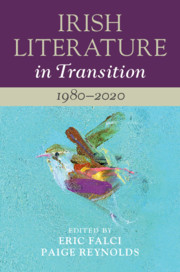Book contents
- Irish Literature in Transition, 1980–2020
- Irish Literature in Transition
- Irish Literature in Transition, 1980–2020
- Copyright page
- Contents
- Contributors
- Series Preface
- General Acknowledgements
- Acknowledgements
- Introduction
- Part I Times
- Chapter 1 The Contemporary Conditions of Irish Language Literature
- Chapter 2 The Cultures of Poetry in Contemporary Ireland
- Chapter 3 Troubles Literature and the End of the Troubles
- Chapter 4 Contemporary Irish Theatre and Media
- Chapter 5 Writing Childhood: Young Adult and Children’s Literature
- Coda: Eavan Boland and Seamus Heaney
- Part II Spaces
- Part III Forms of Experience
- Part IV Practices, Institutions, and Audiences
- Index
Chapter 4 - Contemporary Irish Theatre and Media
from Part I - Times
Published online by Cambridge University Press: 28 February 2020
- Irish Literature in Transition, 1980–2020
- Irish Literature in Transition
- Irish Literature in Transition, 1980–2020
- Copyright page
- Contents
- Contributors
- Series Preface
- General Acknowledgements
- Acknowledgements
- Introduction
- Part I Times
- Chapter 1 The Contemporary Conditions of Irish Language Literature
- Chapter 2 The Cultures of Poetry in Contemporary Ireland
- Chapter 3 Troubles Literature and the End of the Troubles
- Chapter 4 Contemporary Irish Theatre and Media
- Chapter 5 Writing Childhood: Young Adult and Children’s Literature
- Coda: Eavan Boland and Seamus Heaney
- Part II Spaces
- Part III Forms of Experience
- Part IV Practices, Institutions, and Audiences
- Index
Summary
This essay considers the function that media and media devices play in contemporary Irish drama and performance since 1980. In recent realist or naturalist plays, by authors such as Brian Friel, Stacey Gregg, Conor McPherson, and Enda Walsh, media might appear in the text as symbols or plot devices, or in the dramaturgy as props or as design elements. A substantial amount of recent Irish theatre, such as that produced by ANU Productions, Pan Pan Theatre, or Dead Centre, has moved away from the traditional proscenium stage and toward site-specific and immersive theatre that deftly employs multimedia technologies to convey meaning. Amid all of the innovative multimodal varieties of performance and stage craft now on view, there remains in contemporary Irish theatre a powerful commitment to the value of the word and the live body in performance.
Keywords
- Type
- Chapter
- Information
- Irish Literature in Transition: 1980–2020 , pp. 81 - 95Publisher: Cambridge University PressPrint publication year: 2020
- 1
- Cited by

